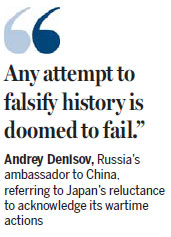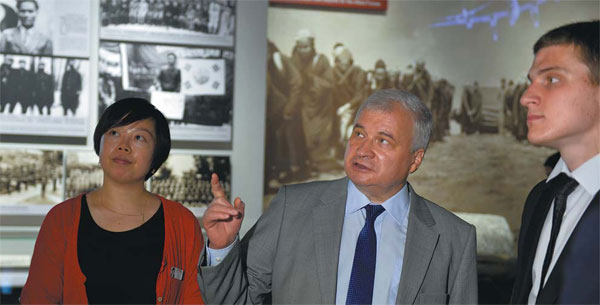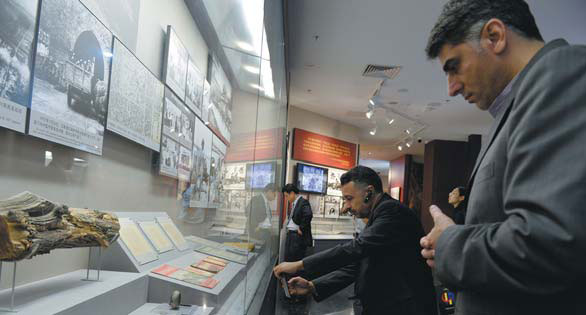Exhibition a reminder of China's battles to 'defend world peace'
More than 500 foreign diplomats, journalists and experts tour Beijing museum
More than 500 foreign diplomats and journalists as well as foreign experts employed by the State Administration of Foreign Experts Affairs visited an exhibition in early July chronicling the War of Resistance against Japanese Aggression.
Held at the Museum of the War of Chinese People's Resistance Against Japanese Aggression in Beijing, the exhibition - titled Great Victory, Historic Contribution - displayed more than 2,800 artifacts and 1,170 pictures, many of which are an assault on the senses.
A spiked metal cage to torture captives, images showing heads mounted on spikes and the disemboweled remains of a raped woman were some of the examples on display to the 184 diplomats from 101 countries - including 37 ambassadors to China and eight charge d'affaires - as well as 140 journalists and 185 foreign experts.
Accompanied by Vice-Minister of Foreign Affairs Zhang Ming during the tour, many of the foreign visitors openly expressed their feelings on the bloody war.
"China made a tremendous contribution to defending world peace through its own sacrifice within the very long struggle against fascist forces, especially those represented by Japan," said Mahesh Kumar Maskey, Nepal's ambassador to China.
Some of them shared their insights of the war while others said the history of the conflict could not be distorted.
"Any attempt to falsify history is doomed to fail," said Andrey Denisov, Russia's ambassador to China, referring to Japan's reluctance to acknowledge its wartime actions.
A consul to the Republic of Korea's embassy in China, who asked not to be named, described the exhibition as "a very good place to experience and see atrocities the Japanese imperialists committed".
"(Japan) should learn from history, understand what they have done and safeguard world peace," said the consul.
Tom Clifford, a senior editor at China Daily, recently wrote in a column for the paper headlined The museum bears harsh testimony to history that people examine the undisputed facts: Japan occupied Manchuria in 1931, a wider invasion began in 1937; and by the time Japan surrendered in 1945, between 13 million and 20 million Chinese people had died. Refugees trying to flee the fighting numbered 100 million.
The site of the museum itself is of historic significance. Located on the outskirts of Beijing, it is located in the Lugouqiao area, the site of the Marco Polo Bridge Incident of 1937.
"The incident, in fact a bloody skirmish between Chinese and Japanese troops, was ignited by reports of a missing Japanese soldier who was later found, and sparked a wider Japanese invasion of China that took place on the outskirts of Beijing.
"It is legitimate to suggest that the incident that sparked the conflict that became World War II occurred not in Poland in 1939 but in China, near this 11-arched bridge, in 1937," he wrote.
"Historians are re-evaluating the significance of what happened in Lugouqiao, and are beginning to view it as the first shots of what became World War II."
70th anniversary
The exhibition is being held ahead of the 70th anniversary of the victory in the China's War of Resistance Against Japanese Aggression. President Xi Jinping and the nation's top leaders were present for the exhibition's opening on July 7.
"We are here for the sake of peace and security. We cannot change the past but the past can prepare for the future. We can forgive, but we can't forget," said Victor Sikonina, Madagascar's ambassador to China.
The exhibition covers 6,700 square meters and is divided into eight parts, including China's fight against Japanese aggression in Northeast China; the country's overall war against Japan; efforts to fight Japan by the Communist Party of China; atrocities made by Japanese invaders; and China's alliance with other Asian countries.

Li Zongyuan, deputy head and spokesman of the museum, said the exhibition's main principle is: Truth speaks for itself.
The exhibit also showcases how people in Macao, Hong Kong and Taiwan fought against Japanese invaders as well as how China was used as one of the main battlefields for the fight against fascism.
Many Chinese visitors have written how the exhibit made a lasting impression on them.
Zhou Shaoyong, a 46-year-old local official in Beijing, wrote in the exhibition's message book, "We should never forget history, but should cherish peace and stability and devote every effort for advancement."
Yun Fan, a 20-year-old at the Hebei University of Technology, wrote, "We should never forget the shame of the country and our generation should shoulder more to spur the takeoff of the country."
A 66-year-old retiree named Liu Shuqin wrote: "My father was a warrior taking part in the war. He used to tell me about a number of bloody and disastrous fights. ... The country's people should cherish the peace and happiness nowadays."
Xinhua contributed to this story.
Contact the writers at yangcheng@chinadaily.com.cn
|
Andrey Denisov (center), Russia's ambassador to China, visits an ongoing exhibition on the War of Resistance against Japanese Aggression. Wei Xiaohao / China Daily |
|
Libya military official Juma Ibrahim (center) and Venezuela consul Miguel Hernndez are among the 500 foreign diplomats, journalists and experts who recently attended the exhibition. Wei Xiaohao / China Daily |
(China Daily 07/24/2015 page7)










